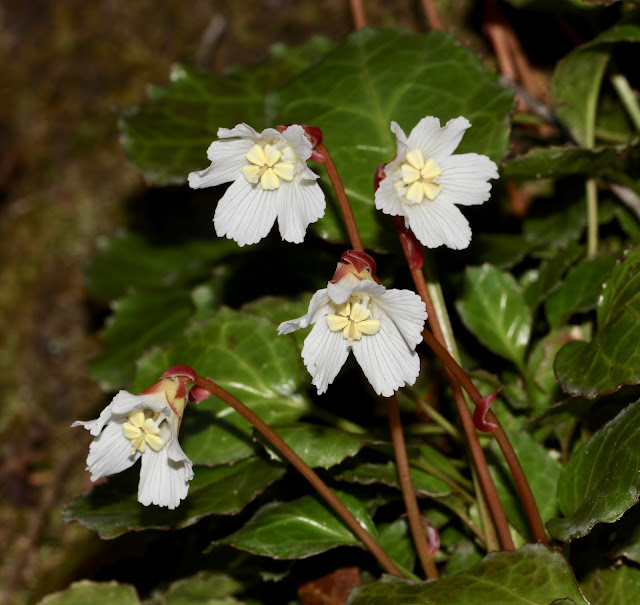SHORTIA GALACIFOLIA
OCONEE BELLS
Most botanist
know the legendary story of Shortia
galacifolia, or Oconee Bells. The plant was originally discovered and
collected in 1788 by French botanist Andre Michaux. His unnamed specimen was
stored in a French herbarium until it was noticed by the American botanist Asa
Gray in 1839. Asa named the plant for another American botanist, Charles W.
Short. When Asa Gray returned to the states he was determined to find the
beautiful Oconee Bell plant. However, his main clue, “in the high mountains of
Carolina”, turned out to be very misleading. Asa and many other botanists
searched high mountain peaks, such as Roan Mountain, Grandfather Mountain and
Mt. Mitchell, for years with no luck. Forty years later in 1877, a 17-year-old
lad named George Hyams found the plants growing along the Catawba River near
Marion, North Carolina. Eventually, word got back to Asa Gray that the plant
had been rediscovered. The ecstatic Gray met with George Hyams and finally saw
the elusive plant in person but he died never seeing the plant in bloom. Gray requested
that his grave in Cambridge, Massachusetts be covered in Oconee Bells.
 |
| American Botanist - Asa Gray (1870's) Photographer Unknown; Public Domain |
The genus
Shortia is within the family Diapensiaceae. There are only five species known
worldwide. All five species are mountainous and relatively rare in occurrence.
Four species are in Asia and the fifth species is endemic to the Southern
Appalachian Mountains of the eastern United States. The American species has two variations; Shortia galacifolia Torrey and Gray var.
galacifolia and S. galacifolia Torrey and Gray var. brevistyla Davies.
Both
variations are found within North Carolina and grow along the moist banks and
slopes of streams in heavy shade created by Rhododendron shrubs. There is often a clear transition between Shortia
and Galax urceolata
plants as one moves up
slope from a stream. Shortia is on the lower, moister, more heavily shaded
parts of the slope. As one moves up the slope, away from the stream, into the
dryer and less shaded higher areas it is replaced by Galax, which also happens to be a member of the family
Diapensiaceae. Shortia’s specific epithet “galacifolia” is due to the
resemblance of Shortia’s leaves to those of its cousin Galax. Both have
clustered, shiny, rounded leaves with serrated to crenate margins. The leaves
of both species can also look reddish or bronzed. However, if you look closely,
Shortia’s leaves are pinnately veined while the leaves of Galax are palmately
veined.
 |
| Shortia galacifolia leaf, note the pinnate veination. |
 |
| Galax urceolata leaves, note the palmate veination. |
Shortia galacifolia Torrey and Gray var. galacifolia was the original species found by Michaux. It is often
referred to as Southern Shortia. The original collection site was destroyed and
flooded by the creation of Lake Jocassee. However, wild populations still exist
in Jackson and Transylvania Counties in N.C., Oconee and Pickens Counties in
South Carolina, and Rabun County in Georgia. The best place to see Oconee Bells
is along the Oconee Bell Nature Trail at Devils Fork State Park in South
Carolina. The plants bloom early in the spring from mid-March to April.
 |
| Shortia galacifolia Torrey and Gray var. galacifolia Photos taken at Devils Fork State Park along the Oconee Bell Nature Trail |
 |
| Shortia galacifolia Torrey and Gray var. galacifolia or Southern Shortia |
 |
| Shortia galacifolia Torrey and Gray var. galacifolia, showing the typical growth habit of the species. |
S. galacifolia Torrey and Gray var. brevistyla Davies is only found in
McDowell County, N.C. It is often called Northern Shortia. The sites are
protected and closed to the public. As its specific epithet implies it has a
shorter style than S. galacifolia var.
galacifolia. Northern Shortia has
styles 6-10mm while the Southern Shortia has styles 12-18 mm in length. Also,
per Flora of North America, Northern Shortia has shorter corolla lobes, 14-17mm,
and Southern Shortia has corolla lobe 16-25 mm in length.
 |
| S. galacifolia Torrey and Gray var. brevistyla Davies, or Northern Shortia, at a protected site in McDowell County, N.C. |
 |
| Close up of a Northern Shortia flower with its shorter corolla lobes and stigma relative to the Southern Shortia variation. |
 |
| Northern Shortia |
 |
| Side view of opening Northern Shortia flower. |
 |
| Nice cluster of Northern Shortia flowers at undisclosed McDowell County site. |
Clemson naturalist Patrick McMillan once said, “So
Oconee Bells was found by a man who didn’t name it. It was named for a man who
never saw it, by a man who couldn’t find it!”
References:
1. Radford, Albert Ernest, Harry E.
Ahles, and Clyde Ritchie Bell. Manual of the
Vascular Flora of the Carolinas. Chapel Hill, NC: U of North Carolina
Press, 1983. Print.
2. Weakley, Alan S. Flora of the Southern
and Mid-Atlantic States. Chapel Hill, NC: U of North Carolina Herbarium,
North Carolina Botanical Garden, U of North Carolina, Chapel Hill, 2015. Print.
3. Flora of North America Editorial
Committee, eds. 1993+. Flora
of North America North of Mexico. 20+ vols. New York and Oxford.
Print.
4. Wildflowers of the United States. (n.d.). Retrieved March
25, 2018, from http://uswildflowers.com/detail.php?SName=Shortia galacifolia.
5. S. (2011,
February 24). O is for Oconee Bells. Retrieved March 25, 2018, from
https://www.youtube.com/watch?v=QTxtvAXSW1A
6. All photographs are taken by and are the property of Tracie Jeffries unless otherwise noted.
6. All photographs are taken by and are the property of Tracie Jeffries unless otherwise noted.